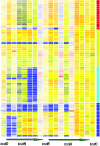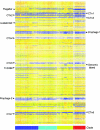Comparative phylogenomics of Clostridium difficile reveals clade specificity and microevolution of hypervirulent strains
- PMID: 17015669
- PMCID: PMC1636221
- DOI: 10.1128/JB.00664-06
Comparative phylogenomics of Clostridium difficile reveals clade specificity and microevolution of hypervirulent strains
Abstract
Clostridium difficile is the most frequent cause of nosocomial diarrhea worldwide, and recent reports suggested the emergence of a hypervirulent strain in North America and Europe. In this study, we applied comparative phylogenomics (whole-genome comparisons using DNA microarrays combined with Bayesian phylogenies) to model the phylogeny of C. difficile, including 75 diverse isolates comprising hypervirulent, toxin-variable, and animal strains. The analysis identified four distinct statistically supported clusters comprising a hypervirulent clade, a toxin A(-) B(+) clade, and two clades with human and animal isolates. Genetic differences among clades revealed several genetic islands relating to virulence and niche adaptation, including antibiotic resistance, motility, adhesion, and enteric metabolism. Only 19.7% of genes were shared by all strains, confirming that this enteric species readily undergoes genetic exchange. This study has provided insight into the possible origins of C. difficile and its evolution that may have implications in disease control strategies.
Figures




Similar articles
-
Genomic and phenotypic studies among Clostridioides difficile isolates show a high prevalence of clade 2 and great diversity in clinical isolates from Mexican adults and children with healthcare-associated diarrhea.Microbiol Spectr. 2024 Jul 2;12(7):e0394723. doi: 10.1128/spectrum.03947-23. Epub 2024 Jun 12. Microbiol Spectr. 2024. PMID: 38864670 Free PMC article.
-
Array comparative hybridisation reveals a high degree of similarity between UK and European clinical isolates of hypervirulent Clostridium difficile.BMC Genomics. 2010 Jun 21;11:389. doi: 10.1186/1471-2164-11-389. BMC Genomics. 2010. PMID: 20565959 Free PMC article.
-
Genomic evolution and virulence association of Clostridioides difficile sequence type 37 (ribotype 017) in China.Emerg Microbes Infect. 2021 Dec;10(1):1331-1345. doi: 10.1080/22221751.2021.1943538. Emerg Microbes Infect. 2021. PMID: 34125660 Free PMC article.
-
Clostridium difficile infection: toxins and non-toxin virulence factors, and their contributions to disease establishment and host response.Gut Microbes. 2012 Mar-Apr;3(2):121-34. doi: 10.4161/gmic.19399. Epub 2012 Mar 1. Gut Microbes. 2012. PMID: 22555464 Free PMC article. Review.
-
Hypervirulent strains of Clostridium difficile.Postgrad Med J. 2007 May;83(979):291-5. doi: 10.1136/pgmj.2006.056143. Postgrad Med J. 2007. PMID: 17488855 Free PMC article. Review.
Cited by
-
Subtyping analysis reveals new variants and accelerated evolution of Clostridioides difficile toxin B.Commun Biol. 2020 Jul 3;3(1):347. doi: 10.1038/s42003-020-1078-y. Commun Biol. 2020. PMID: 32620855 Free PMC article.
-
Comparative transcriptional analysis of clinically relevant heat stress response in Clostridium difficile strain 630.PLoS One. 2012;7(7):e42410. doi: 10.1371/journal.pone.0042410. Epub 2012 Jul 30. PLoS One. 2012. PMID: 22860125 Free PMC article.
-
Using phenotype microarrays to determine culture conditions that induce or repress toxin production by Clostridium difficile and other microorganisms.PLoS One. 2013;8(2):e56545. doi: 10.1371/journal.pone.0056545. Epub 2013 Feb 20. PLoS One. 2013. PMID: 23437164 Free PMC article.
-
Clostridium difficile colitis: pathogenesis and host defence.Nat Rev Microbiol. 2016 Oct;14(10):609-20. doi: 10.1038/nrmicro.2016.108. Epub 2016 Aug 30. Nat Rev Microbiol. 2016. PMID: 27573580 Free PMC article. Review.
-
Prevalence and diversity of toxigenic Clostridium perfringens and Clostridium difficile among swine herds in the midwest.Appl Environ Microbiol. 2010 May;76(9):2961-7. doi: 10.1128/AEM.02459-09. Epub 2010 Mar 5. Appl Environ Microbiol. 2010. PMID: 20208029 Free PMC article.
References
-
- Brazier, J. S. 2001. Typing of Clostridium difficile. Clin. Microbiol. Infect. 7:428-431. - PubMed
-
- Chaves-Olarte, E., P. Low, E. Freer, T. Norlin, M. Weidmann, C. von Eichel-Streiber, and M. Thelestam. 1999. A novel cytotoxin from Clostridium difficile serogroup F is a functional hybrid between two other large clostridial cytotoxins. J. Biol. Chem. 274:11046-11052. - PubMed
-
- Clabots, C. R., S. Johnson, K. M. Bettin, P. A. Mathie, M. E. Mulligan, D. R. Schaberg, L. R. Peterson, and D. N. Gerding. 1993. Development of a rapid and efficient restriction endonuclease analysis typing system for Clostridium difficile and correlation with other typing systems. J. Clin. Microbiol. 31:1870-1875. - PMC - PubMed
Publication types
MeSH terms
Substances
Grants and funding
LinkOut - more resources
Full Text Sources
Other Literature Sources
Molecular Biology Databases

